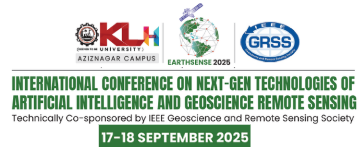The conference will cover a wide range of topics, emphasizing the latest technologies and their applications across various domains. Below are the suggestive tracks with subtopics(but not limited to..)
Advanced Remote Sensing Technologies:
- Next-generation satellite platforms (e.g., smallsats, cubesats, hyperspectral sensors).
- Innovations in LiDAR, SAR (Synthetic Aperture Radar), and thermal imaging.
- UAVs (Unmanned Aerial Vehicles) and drone-based sensing for environmental monitoring.
- AI and machine learning for image processing and geospatial data analysis.
Sensors in Remote Sensing Technologies:
- AI-Driven Data Processing for Remote Sensing Sensors
- Integrating data from multiple sensors to improve accuracy and insights.
- Low-Cost and Miniaturized Sensors for small-scale, affordable remote sensing systems
- Applications of Thermal and Infrared Sensors in Environmental Monitoring
- Urban planning and land-use analysis through sensor data.
- Sensor fusion methodologies for multi-source data integration
Climate Change and Disease Monitoring:
- Impact of changing climates on the prevalence of infectious diseases
- Geospatial monitoring of emerging health risks due to extreme weather events
- AI models for predicting climate-sensitive diseases (e.g., cholera, heatstroke)
- Remote sensing of water sources to study waterborne diseases
- Identifying regions vulnerable to climate-induced health crises
Natural Hazard Detection and Disaster Management:
- Early warning systems for earthquakes, floods, and landslides using remote sensing.
- Satellite-based monitoring for disaster response and recovery.
- Real-time data for wildfire detection and mitigation.
- Role of geospatial data in post-disaster healthcare delivery and logistics.
Environmental Monitoring and Sustainability:
- Remote sensing of ecosystems: biodiversity, land use, and vegetation analysis.
- Water resource monitoring and hydrology using satellite data.
- Precision agriculture: Monitoring soil health, crop yield prediction, and pest control.
- Urban sustainability: Mapping urban heat islands, pollution, and resource management.
Data Fusion and Big Data Analytics:
- Integration of multi-sensor and multi-platform data for enhanced Earth observation.
- Big data platforms for geospatial data storage, analysis, and visualization.
- Cloud computing for real-time geospatial data processing.
- High-performance computing for large-scale geospatial simulations.
Sustainable Agriculture and Forestry Management :
- AI for crop monitoring and yield prediction using remote sensing
- Early detection of pests and diseases in vegetation with geospatial data
- Remote sensing for forest biomass and carbon stock estimation
- Geo-AI for precision farming and irrigation optimization
- Monitoring afforestation and reforestation projects with satellite imagery
- Climate change effects on vegetation patterns using remote sensing data
Geoscience in Energy and Renewable Resource Management:
- Remote sensing for exploration and sustainable extraction of natural resources.
- Monitoring renewable energy infrastructure (solar, wind, hydropower).
- Environmental impact assessments of mining, drilling, and deforestation activities.
- Energy efficiency monitoring in urban and industrial areas.

